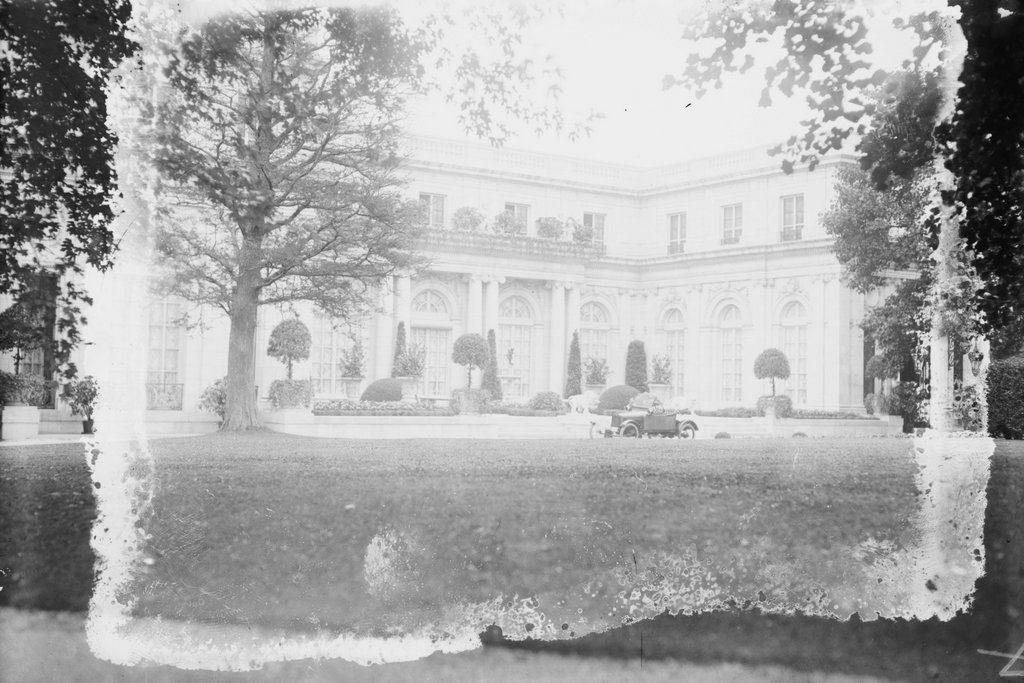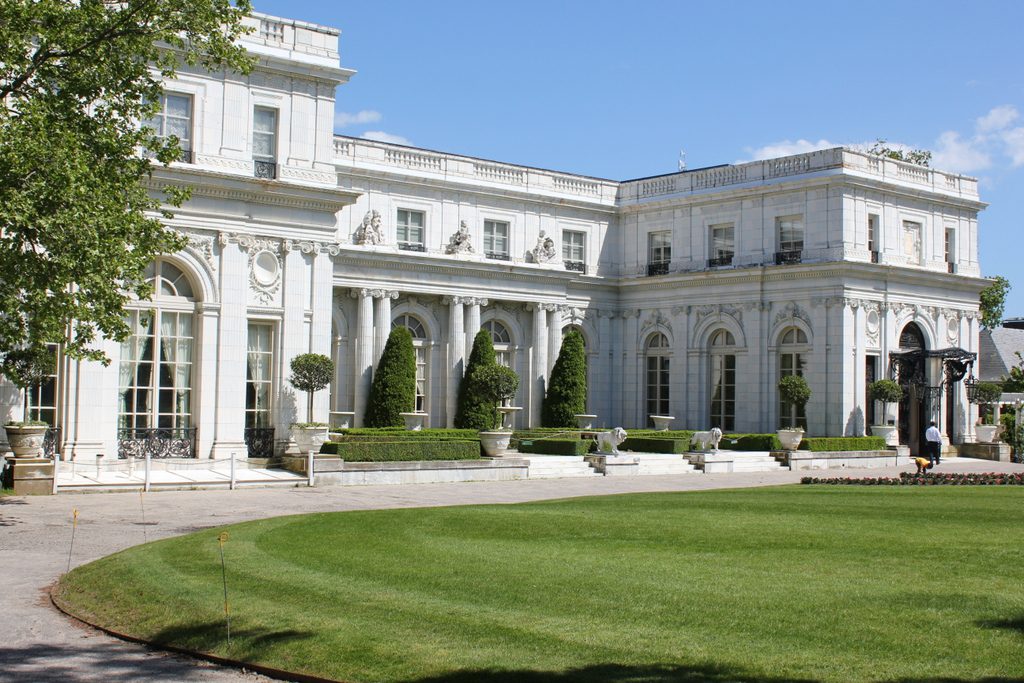The Rosecliff mansion on Bellevue Avenue in Newport, around 1910-1915. Image courtesy of the Library of Congress, George Grantham Bain Collection.
The scene in 2018:
Rosecliff was one of the many Gilded Age summer homes that were built in Newport during the late 19th and early 20th centuries. It was completed in 1902, and was originally the home of businessman Hermann Oelrichs (1850-1906) and his wife, the silver heiress Theresa Fair Oelrichs (1871-1926). The property had previously been owned by George Bancroft (1800-1891), a prominent historian, politician, and diplomat who had served as U. S. Secretary of the Navy from 1845 to 1846, Minister to the United Kingdom from 1846 to 1849, and Minister to Germany from 1867 to 1874. During this time, he maintained a modest summer home here in Newport, which was named Rosecliff for his extensive rose garden.
Following Bancroft’s death in 1891, the Oelrichs purchased the Rosecliff property. The old house was demolished, and they hired the prominent architectural firm of McKim, Mead & White to design a new, larger, and far more elegant replacement. Most of the design work was done by Stanford White, whose earlier Newport commissions included the Isaac Bell House. Although built less than 20 years after the Isaac Bell House, Rosecliff represented a significant shift in White’s designs, from the Shingle style of the 1880s to the Beaux-Arts style of the turn of the century. It also reflected the changes in tastes among the Newport elite, who increasingly demanded summer “cottages” that were modeled after European palaces. In this case, Rosecliff was based on the design of the Grand Trianon at Versailles, which had been built during the reign of Louis XIV.
Hermann and Theresa Oelrichs lived in New York, but spent summers here at Rosecliff, where Theresa was one of the leaders of Newport society. As such, her house was designed for entertaining. Its ballroom, which measures 40 by 80 feet, is the largest in Newport, and it occupies the entire central section of the first floor, between the two projecting wings. The entire house has a total of 30 rooms, is 28,800 square feet in size, and was built at a cost of $2.5 million, or over $73 million today.
The house was built using the wealth that Theresa had inherited from her father, James Graham Fair (1831-1894). Fair had come to the United States in 1843 as a poor young Irish immigrant, but he went on to make his fortune in silver mining following the discovery of the Comstock Lode in Nevada. He also served one term as a U. S. Senator from Nevada, from 1881 to 1887, but was defeated for re-election in 1886. Despite – or perhaps because of – this vast wealth, Fair had a strained relationship with his wife and children, thanks in no small part to his serial adultery. His wife, also named Theresa, divorced him in 1883, and his daughter Theresa did not even invite him to her wedding in 1890. However, this did not stop the younger Theresa from accepting his $1 million wedding gift, nor the $40 million inheritance that she and her sister split after his death in 1894. She would eventually honor his legacy by building the Fairmont Hotel in San Francisco and naming it for him.
Hermann Oelrichs died in 1906, but Theresa continued to spend summers here at Rosecliff until her death in 1926 at the age of 55. Her only child, Hermann Oelrichs, Jr. (1891-1948) inherited the property, but by this point Newport’s massive Gilded Age mansions were falling out of fashion. This would only get worse in the wake of the Great Depression, and Oelrichs ultimately sold the house in 1941 for just $21,000. Adjusted for inflation, this was less than a half of a percent of what his parents had spent to build Rosecliff only 40 years earlier.
The new owner of Rosecliff was Gertrude Niesen (1911-1975), a singer, actress, and Vaudeville performer who was active during the 1930s and 1940s. She owned it for several years, but during this time the house sustained serious damage from a frozen water pipe. She subsequently sold it to Ray Alan Van Clief, who restored the interior, but he was killed in a car accident while on his way to visit the house for the first time after the completion of the renovations.
The next owner of the house was J. Edgar Monroe (1897-1992), a wealthy New Orleans businessman who purchased the property in 1947. He and his wife Louise spent summers here until 1971, when they donated Rosecliff to the Preservation Society of Newport County, a nonprofit organization that owns many of the historic mansions in Newport, including The Breakers and Marble House. The house was opened to the public, and over the years it has also been used as a filming location for a variety of movies, including The Great Gatsby (1974), True Lies (1994), Amistad (1997), and 27 Dresses (2008). Today, the exterior of the house has not significantly changed since the first photo was taken over a century ago, and it is now a contributing property in the Bellevue Avenue Historic District, which was designated as a National Historic Landmark district in 1973.



Interesting history. Toured it a few times and enjoyed the stories about the White Party, where a copy of the Great White Fleet was built and “sailed “ in the Atlantic behind the estate. Every summer $25,000 of perfume was put in the vials behold the lights in the beautiful crystal chandeliers
My dad had the distinctive honor of restoring the outside of the Rose Cliff. He worked on the back of the mansion in the winter and the front in the summer. At the end of the restoration he was invited to a grand gala to celebrate the reopening. He was so proud when many dignitaries came and shook his hand. Just a memory but a good one
That is a wonderful story. So proud of all of your father’s hard work. This was my then boyfriend and mine favorite mansion. I did wind up marrying him and his last name is “Valentine.” So he “had” planned to propose to me under the “heart shaped” staircase in front of all the tourists etc. However, he did not realize that The Rosecliff was closed in December. He had the ring and everything! So we snuck on to the property, slipped in under the chain to the back to the famous fountain that Mia Farrow had the white swans in, in the movie “The Great Gatsby!” I had my black, velvet robe with hood on and he bent down on one knee (it was rather cold, ha) and proposed. I said YES of course and he took pictures of me. We have been married for 28 years and have three beautiful children. I wanted to get married there, but none of the Catholic Churches would marry me, because I did not live there full time. So I got married in the Church I walked to with my grandmother when I was five and the Mass was in Latin at Sacred Heart Church, Newark, NJ. I had my reception at the famous “Twombly Estate” (cousins to the Vanderbilts) at FDU in Madison, NJ! If you graduate from the school you are allowed to pay to have your wedding there! I designed the bridesmaids gowns to be reminiscent of the 1890’s and made lavender ostrich feathered fans for them to carry. They had lavender, long silk gloves and sausage curls etc. The grounds were amazing for pictures too! They walked down the isle of the huge Church to “A Time For Us” from Romeo and Juliet!
What an interesting history to this mansion..
I especially like the very last story where the man who worked on it last was invited to the grand gala to celebrate.
Very nice.
loved Newport extensively.. with & without Ilse & Peter.
Still have a belt purchased at the Army Navy store that used to be there…Spent our Honeymoon there in 86..L.L.
Kudos to the Society for Preservation of Newport that keeps an energetic team of people for all of us tourist and Gilded Age enthusiasts to visit! My respects!